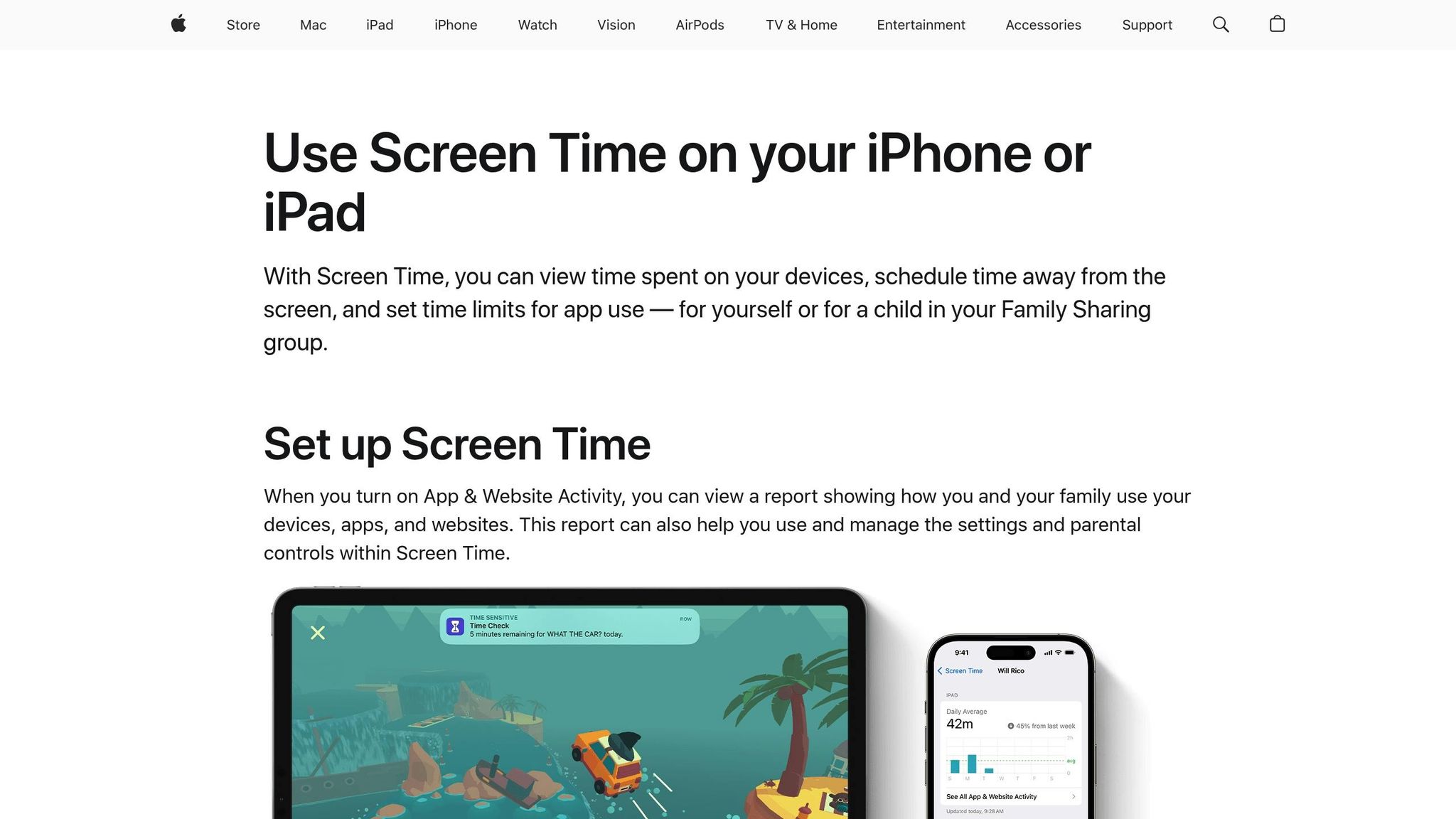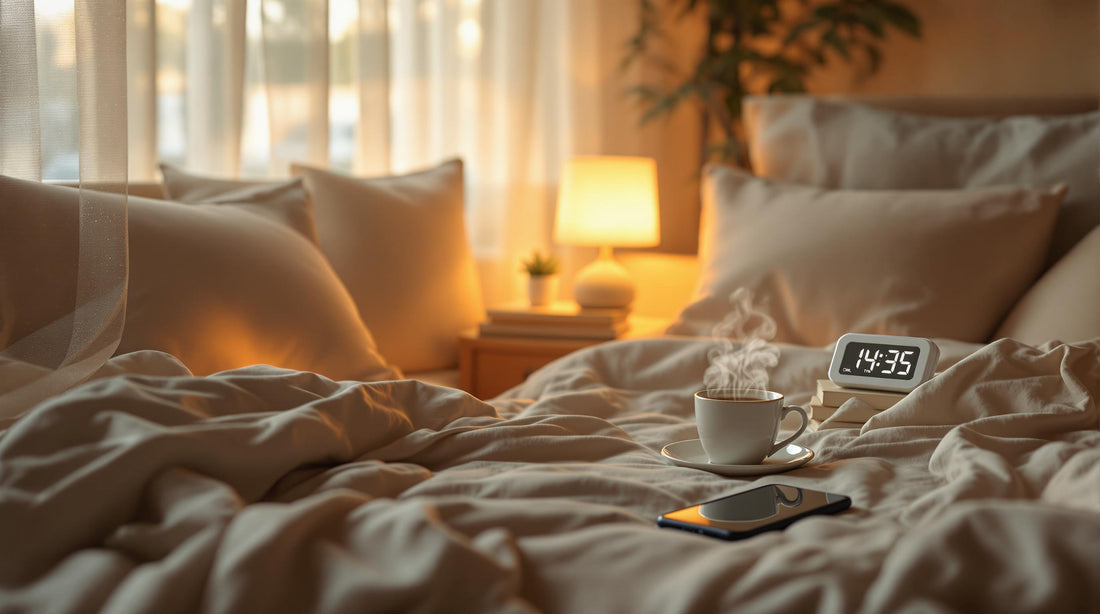Using screens before bed can disrupt sleep, leaving you tired and unfocused. Blue light from devices suppresses melatonin, making it harder to fall asleep. To improve your sleep quality, try these 8 tips:
- Set a device cutoff time: Stop using screens 1–2 hours before bed.
- Try screen-free activities: Read, stretch, or journal instead of scrolling.
- Keep devices out of the bedroom: Charge them in another room.
- Adjust device settings: Use Night Shift or Night Light to reduce blue light.
- Track and limit screen time: Use built-in tools to monitor usage.
- Build offline hobbies: Engage in activities like painting or knitting.
- Create a sleep-friendly bedroom: Dim lighting, blackout curtains, and a cool temperature (65–68°F) help.
- Use tools for better sleep: Products like nasal breathing aids can improve sleep quality.
Start small - set a screen cutoff time 30 minutes before bed and gradually increase it. Better sleep will boost your energy, mood, and health.
Getting a Good Night’s Sleep: Screen-Time and Melatonin
How Screen Time Affects Sleep

Understanding how screen exposure impacts sleep can help improve bedtime habits. Spending too much time on screens can disrupt the sleep-wake cycle and interfere with natural sleep patterns.
Blue Light and Its Impact on Sleep
Digital devices emit blue light, which can suppress melatonin production - the hormone responsible for regulating sleep. This suppression can make it harder to fall asleep and may lower the overall quality of sleep. Studies continue to highlight how this interference contributes to ongoing sleep issues.
What Research Says About Screens and Sleep
Studies consistently show a connection between screen use before bed and poorer sleep quality. For instance, the National Sleep Foundation found that 95% of people use a screen device within an hour of bedtime, even though research warns against it.
Screen time can also amplify other sleep problems. For example, pairing excessive screen use with habits like mouth breathing can worsen the effects on sleep quality.
"According to experts such as James Nestor and Dr. Andrew Huberman, mouth taping holds the secret to improved sleep by promoting nasal breathing." - lulltape.com
Adopting better screen habits before bed can lead to more restful sleep and better overall health. Recognizing these effects is a step toward building healthier night-time routines.
sbb-itb-31084ec
8 Ways to Cut Down Screen Time at Night
Here are eight practical tips to help reduce screen time in the evening and improve your sleep routine.
1. Set a Device Cutoff Time
Stop using screens 1–2 hours before bed to let your body naturally produce melatonin. For example, if you aim to sleep by 10:30 PM, set your device cutoff time at 9:00 PM. Use tools like Apple's Screen Time or Android's Digital Wellbeing to schedule reminders and stay on track.
2. Try Screen-Free Evening Activities
Swap digital entertainment for calming activities that prepare your body for rest. Reading a physical book, stretching, or journaling can help you relax without the disruptive effects of blue light.
3. Keep Devices Out of the Bedroom
Create a habit of charging your devices outside the bedroom to avoid late-night scrolling. A designated charging station in a common area, like the kitchen or office, can help maintain a screen-free sleep space.
4. Adjust Your Device Settings
If you must use devices in the evening, tweak the settings to minimize blue light exposure. Enable features like Night Shift (iPhone) or Night Light (Android), and lower the screen brightness to a comfortable level.
5. Track and Limit Screen Time
Use built-in tools on your devices to monitor your daily screen time. Reviewing app usage can help you identify patterns and set limits, especially for evening hours.
6. Build Offline Hobbies
Find enjoyable offline activities that can replace screen time in the long run. Consistent habits like painting, knitting, or playing a musical instrument can naturally reduce your reliance on devices.
7. Create a Sleep-Friendly Bedroom
Transform your bedroom into a relaxing, screen-free zone. Use dim lighting, install blackout curtains, and keep the temperature cool - ideally between 65–68°F (18–20°C).
8. Use Tools to Support Sleep
Consider tools that encourage better sleep. For example, products like lulltape can promote nasal breathing, reduce snoring, and improve overall sleep quality.
| Time Before Bed | Recommended Activities | Activities to Avoid |
|---|---|---|
| 2 hours | Reading, stretching, journaling | Social media, video games |
| 1 hour | Yoga, meditation, bedtime prep | Email, news apps |
| 30 minutes | Deep breathing, applying sleep aids | Phone use, texting |
Conclusion: Building Better Evening Habits
The tips shared above can help you create healthier nighttime routines and improve your sleep. Swapping screen time for relaxing, offline activities allows your body and mind to wind down effectively before bed.
Stick to a consistent bedtime routine, including setting a device cutoff time. Start with 30 minutes before bed and gradually increase it as the habit becomes second nature. Better sleep directly impacts your energy levels, mood, and overall health.
Incorporating tools like lulltape, which can enhance oxygen intake by up to 20% during sleep, adds another layer of support to your efforts in reducing screen exposure and improving evening habits.
To make these changes stick, focus on these core steps:
- Set a clear device cutoff time.
- Keep your bedroom cool and free of screens.
- Engage in relaxing offline activities before bed.
- Use tools to support better breathing during sleep.



